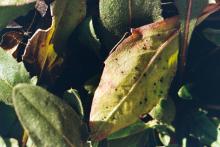Cause Puccinia cyani (var. sublevis), a fungus, has been reported on Centaurea from Washington and Oregon. It has been suggested that this rust was imported on seed from Europe, with subsequent abundant local spread either aerially or with the seed. The fungus can complete its life cycle on this host. Airborne spores are spread from living tissue. Warm wet conditions favor infection and disease development.
Puccinia jaceae var. solstitialis has been used as a biocontrol (mycoherbicide) on the invasive weed yellow starthistle (Centaurea solstitialis). This rust was established in southern Oregon. Puccinia jaceae was also found on spotted knapweed (Centaurea stoebe) in Idaho.
Symptoms Leaves and stems may be covered with brown pustules.
Cultural control
- Plant clean seed.
- Remove and destroy infected plant debris at year-end.
- Avoid overhead irrigation, or water such that plants are not wet for extended periods of time.
References Bruckart III, W.L., Michael, J.L., Coombs, E.M., and Pirosko, C.B. 2016. Rust Pathogen Puccinia jaceae is Established on Yellow Starthistle (Centaurea solstitialis) in Oregon. Plant Disease 100:1009.
Newcombe, G., Gaylord, R., Yenish, J. P., Mastrogiuseppe, J., and Dugan, F. M. 2009. New records for pathogenic fungi on weedy or non-indigenous plants. North American Fungi, 4:1-12.


